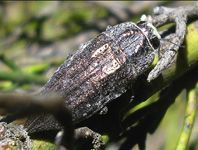Abstract
The genus Ectinogonia Spinola, 1837 is a genus mainly found in Chile; it currently contains 17 species. Recent exploration in the Andes Mountain Range of the Bio Bio Region in Chile have resulted in the collection of specimens slightly different morphologically from all previously described species. The aim of this paper is to describe this new species of Ectinogonia using morphological and genetic evidence. To establish differences between species we described the external morphology and compared it to species that are morphologically similar (i.e. E. buqueti Spinola 1837 and E. intermedia Kerremans 1903). We also measured the genetic differences in COI sequences, constructing a distance matrix in which we compared it to species that are morphologically similar (E. buqueti and E. intermedia) and other species found in the same region (E. speciosa oscuripennis Moore 1994). We found that E. cryptica sp. n. differs from E. buqueti (which previously contained E. cryptica sp. n.) in pronotum and elytral patterns. The genetic distance matrix shows that E. cryptica sp. n. differs by 4.6% from all other Ectinogonia species compared, supporting the morphological evidence.
References
Bellamy, C.L. (2006) The Systematic Position of Certain South American Buprestid Genera (Coleoptera: Buprestidae). The Coleopterists Bulletin, 60 (2), 192–196.
https://doi.org/10.1649/909.1
Bickford, D., Lohman, D.J., Sodhi, N.S., Ng, P.K., Meier, R., Winker, K., Ingram, K.K. & Das, I. (2007) Cryptic species as a window on diversity and conservation. Trends in ecology & evolution, 22 (3), 148–155
https://doi.org/10.1016/j.tree.2006.11.004
Clarissa, M.H. & Simmons, L.W. (2003) Genital morphology and fertilization success in the dung beetle Onthophagus taurus: an example of sexually selected male genitalia. Proceedings of the Royal Society B: Biological Sciences, 270 (1514), 447–455.
https://doi.org/10.1098/rspb.2002.2266Cobos, A. (1954) Revisión de las Ectinogonia Spinola sensu strictus Coleoptera, Buprestidae. Revista Chilena de Entomología, 3 (1953), 41–68.
Hall, T.A. (1999) BioEdit: a user-friendly biological sequence alignment editor and analysis program for Windows 95/98/NT. Nucleic Acids Symposium Series, 41, 95–98.
Han, T., Kang, T., Jeong, J., Lee, Y., Chung, H., Park, S., Lee, S., Kim, K. & Park, H. (2012) Pseudocryptic speciation of Chrysochroa fulgidissima (Coleoptera: Buprestidae) with two new species from Korea, China and Vietnam. Zoological Journal of the Linnean Society, 164, 71–98.
https://doi.org/10.1111/j.1096-3642.2011.00763.xHansen, J.A., Moulton, J.K., Klingeman, W.E., Oliver, J.B., Windham, M.T., Trigiano, R.N. & Reding, M.E. (2015) Molecular Systematics of the Chrysobothris femorata Species Group (Coleoptera: Buprestidae). Annals of the Entomological Society of America, 108 (5), 950–963.
https://doi.org/10.1093/aesa/sav080Hebert, P.D., Cywinska, A. & Ball, S.L. (2003) Biological identifications through DNA barcodes. Proceedings of the Royal Society of London B: Biological Sciences, 270 (1512), 313–321.
https://doi.org/10.1098/rspb.2002.2218Hebert, P.D., Ratnasingham, S. & de Waard, J.R. (2003b) Barcoding animal life: cytochrome c oxidase subunit 1 divergences among closely related species. Proceedings of the Royal Society of London B: Biological Sciences, 270 (Supplement 1), S96–S99.
https://doi.org/10.1098/rsbl.2003.0025Hebert, P.D., Penton, E.H., Burns, J.M., Janzen, D.H. & Hallwachs, W. (2004) Ten species in one: DNA barcoding reveals cryptic species in the neotropical skipper butterfly Astraptes fulgerator. Proceedings of the National Academy of Sciences of the United States of America, 101 (41), 14812–14817.
https://doi.org/10.1073/pnas.0406166101Hopwood, P.E., Head, M.L., Jordan, E.J., Carter, M.J., Davey, E., Moore, A.J. & Royle, N.J. (2016) Selection on an antagonistic behavioral trait can drive rapid genital coevolution in the burying beetle, Nicrophorus vespilloides. Evolution, 70 (6), 1180–1188.
https://doi.org/10.1111/evo.12938Jowett, T. (1986) Preparation of nucleic acids. In: Roberts, D.B. (Eds.), Drosophila: a practical approach. IRL Press, Oxford, pp. 275–286.
https://doi.org/10.1002/dvg.1020080108Kerremans, C. (1903) Genera Insectorum, publies par P. Wytsman. Briissel, Fasc 12, 1–338.
Tamura, K., Stecher, G., Peterson, D., Filipski, A. & Kumar, S. (2013) MEGA6: Molecular Evolutionary Genetics Analysis version 6.0. Molecular Biology and Evolution, 30, 2725–2729.
https://doi.org/10.1093/molbev/mst197Masly, J.P. (2012) 170 Years of “Lock-and-Key”: Genital Morphology and Reproductive Isolation. International Journal of Evolutionary Biology, 2012, 1–10.
https://doi.org/10.1155/2012/247352Moore, T. (1994) Revisión del género Ectinogonia Spinola para Chile (Coleoptera: Buprestidae). Boletín de la Sociedad de Biología de Concepción, 65, 153–166.
Moore, T. & Vidal, P. (2015) Análisis de las Especies Chilenas. In: Moore, T. & Vidal, P. (Eds.), Los Bupréstidos de Chile. Ediciones Universidad Católica de Chile, Santiago, pp. 27–337.
Obenberger, J. (1926) Buprestidae I. In: Junk, W. & Schlenkling, S. (Eds.), Coleopterorum Catalogus. W. Junk, Berlin, pp. 1–212.
Pentinsaari, M., Mutanen, M. & Kaila, L. (2014) Cryptic diversity and signs of mitochondrial introgression in the Agrilus viridis species complex (Coleoptera: Buprestidae). European Journal of Entomology, 111 (4), 475.
https://doi.org/10.14411/eje.2014.072Polihronakis, M. (2006) Morphometric analysis of intraspecific shape variation in male and female genitalia of Phyllophaga hirticula (Coleoptera: Scarabaeidae: Melolonthinae). Annals of the entomological Society of America, 99 (1), 144–150.
https://doi.org/10.1603/0013-8746(2006)099[0144:MAOISV]2.0.CO;2Pons, J., Barraclough, T., Gomez-Zurita, J., Cardoso, A., Duran, A., Hazell, S., Kamoun, S., Sumlin, W. & Vogler, A. (2006) Sequence-based species delimitation for the DNA taxonomy of undescribed insects. Systematic biology, 55 (4), 595–609.
https://doi.org/10.1080/10635150600852011Richards, O.W. (1927) The specific characters of British Humblebees (Hymenoptera). Transactions of the Royal Entomological Society of London, 75 (2), 233–268.
https://doi.org/10.1111/j.1365-2311.1927.tb00073.xSolier (1849) Historia física y política de Chile. Gay Tomo IV. en el Museo de historia natural de Santiago, En casa del autor, Paris, 500 pp.
Spinola, M. (1837) Lettre addressee a la Société Entomologique de France sur un groupe de Buprestides. Annales de la Société Entomologique de France, 6, 101–122.
Thompson, J.D., Higgins, D.G. & Gibson, T.J. (1994) CLUSTAL W: improving the sensitivity of progressive multiple sequence alignment through sequence weighting, position-specific gap penalties and weight matrix choice. Nucleic acids research, 22 (22), 4673–4680.
https://doi.org/10.1093/nar/22.22.4673Zehner, R., Amendt, J., Schütt, S., Sauer, J., Krettek, R. & Povolný, D. (2004) Genetic identification of forensically important flesh flies (Diptera: Sarcophagidae). International journal of legal medicine, 118 (4), 245–247.
https://doi.org/10.1007/s00414-004-0445-4

